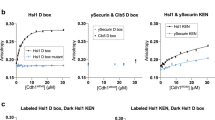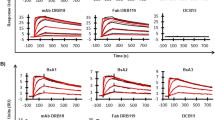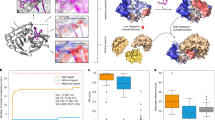Abstract
Biological experiments at the solid/liquid interface, in general, require surfaces with a thin layer of purified molecules, which often represent precious material. Here, we have devised a method to extract proteins with high selectivity from crude biological sample solutions and place them on a surface in a functional, arbitrary pattern. This method, called affinity-contact printing (αCP), uses a structured elastomer derivatized with ligands against the target molecules. After the target molecules have been captured, they are printed from the elastomer onto a variety of surfaces. The ligand remains on the stamp for reuse. In contrast with conventional affinity chromatography, here dissociation and release of captured molecules to the substrate are achieved mechanically. We demonstrate this technique by extracting the cell adhesion molecule neuron-glia cell adhesion molecule (NgCAM) from tissue homogenates and cell culture lysates and patterning affinity-purified NgCAM on polystyrene to stimulate the attachment of neuronal cells and guide axon outgrowth.
This is a preview of subscription content, access via your institution
Access options
Subscribe to this journal
Receive 12 print issues and online access
$259.00 per year
only $21.58 per issue
Buy this article
- Purchase on SpringerLink
- Instant access to full article PDF
Prices may be subject to local taxes which are calculated during checkout




Similar content being viewed by others
References
Lvov, Y. & Möhwald, H. (eds). Protein architecture. (Marcel Dekker, New York; 2000).
Deutscher, M.P. (ed). Guide to protein purification. Methods Enzymol. 182 (entire volume; 1990).
Dean, P.D.G., Johnson, W.S. & Middle, F.A. (eds). Affinity chromatography: a practical approach. (IRL, Oxford, Washington, DC; 1985).
Xia, Y. & Whitesides, G.M. Soft lithography. Angew. Chem. Int. Ed. Engl. 37, 551–575 (1998).
Kumar, A., Biebuyck, H. & Whitesides, G.M. Patterning SAMs: application in material science. Langmuir 10, 1498–1511 (1994).
Delamarche, E., Bernard, A., Schmid, H., Michel, B. & Biebuyck, H. Patterned delivery of immunoglobulins to surfaces using microfluidic networks. Science 276, 779–781 (1997).
Bernard, A. et al. Printing patterns of proteins. Langmuir 14, 2225–2229 (1998).
Bernard, A., Renault, J.P., Michel, B., Bosshard, H.R. & Delamarche, E. Microcontact printing of proteins. Adv. Mat. 12, 1067–1070 (2000).
Florin, E.-L., Moy, V.T. & Gaub, H.E. Adhesion forces between individual ligand–receptor pairs. Science 264, 415–417 (1994).
Cluzel, P. et al. DNA: an extensible molecule. Science 271, 792–794 (1996).
Rief, M., Gautel, M., Oesterhelt, F., Fernandez, J.M. & Gaub, H.E. Reversible unfolding of individual titin immunoglobulin domains by AFM. Science 276, 1109–1112 (1997).
Grandbois, M., Beyer, M., Rief, M., Clausen-Schaumann, H. & Gaub, H.E. How strong is a covalent bond? Science 283, 1727–1730 (1999).
Moy, V.T., Florin, E.-L. & Gaub, H.E. Intermolecular forces and energies between ligands and receptors. Science 266, 257–259 (1994).
Strunz, T., Oroszlan, K., Schäfer, R. & Güntherodt, H.-J. Dynamic force spectroscopy of single DNA molecules. Proc. Natl. Acad. Sci. USA 96, 11277–11282 (1999).
Heymann, B. & Grubmüller, H. Dynamic force spectroscopy of molecular adhesion bonds. Phys. Rev. Lett. 84, 6126–6128 (2000).
Lemmon, V., Farr, K.L. & Lagenaur, C. L1-mediated axon outgrowth occurs via homophilic binding mechanism. Neuron 2, 1597–1603 (1989).
Singhvi, R. et al. Engineering cell shape and function. Science 264, 696–698 (1994).
Chen, C.S., Mrksich, M., Huang, S., Whitesides, G.M. & Ingber, D.E. Geometric control of cell life and death. Science 276, 1425–1428 (1997).
Mrksich, M., Dike, L.E., Tien, J., Ingber, D.E. & Whitesides, G.M. Using microcontact printing to pattern the attachment of mammalian cells to self-assembled monolayers of alkanethiolates on transparent films of gold and silver. Exp. Cell Res. 235, 305–313 (1997).
Matsuzawa, M., Tokumitsu, S., Knoll, W. & Sasabe, H. . Effects of organosilane monolayer films on the geometrical guidance of CNS neurons. Langmuir 14, 5133–5138 (1998).
Branch, D.W., Corey, J.M., Weyhenmeyer, J.A., Brewer, G.J. & Wheeler, B.C. Micro-stamp patterns of biomolecules for high-resolution neuronal networks. Med. Biol. Eng. Comput. 36, 135–141 (1998).
Stoeckli, E.T., Ziegler, U., Bleiker, A.J., Groscurth, P. & Sonderegger, P. Clustering and functional cooperation of NgCAM and axonin-1 in the substratum-contact area of growth cones. Dev. Biol. 177, 15–29 (1996).
Sonderegger, P., Lemkin, P.F., Lipkin, L.E. & Nelson, P.G. Differential modulation of the expression of axonal proteins by non-neuronal cells of the peripheral and central nervous system. EMBO J. 4, 1395–1401 (1985).
Stoeckli, E.T., Kuhn, T.B., Duc, C.O., Ruegg, M.A. & Sonderegger, P. The axonally secreted protein axonin-1 is a potent substratum for neurite growth. J. Cell Biol. 112, 449–455 (1991).
Ruegg, M.A. et al. Purification of axonin-1, a protein that is secreted from axons during neurogenesis. EMBO J. 8, 55–63 (1989).
Acknowledgements
We thank Stefan Kunz of the Sonderegger group, Helga Sorribas of the Paul Scherrer Institute, and Heinz Schmid of IBM for helpful discussions and preparations, as well as Pierre Guéret and Paul Seidler for their support. This work was supported in part by the Swiss National Science Foundation NFP 36 project.
Author information
Authors and Affiliations
Corresponding author
Rights and permissions
About this article
Cite this article
Bernard, A., Fitzli, D., Sonderegger, P. et al. Affinity capture of proteins from solution and their dissociation by contact printing. Nat Biotechnol 19, 866–869 (2001). https://doi.org/10.1038/nbt0901-866
Received:
Accepted:
Issue date:
DOI: https://doi.org/10.1038/nbt0901-866
This article is cited by
-
Functional imaging of neuron–astrocyte interactions in a compartmentalized microfluidic device
Microsystems & Nanoengineering (2016)
-
Neuron Image Analyzer: Automated and Accurate Extraction of Neuronal Data from Low Quality Images
Scientific Reports (2015)
-
Molecular analysis for medicine: a new technological platform based on nanopatterning and label-free optical detection
Oncologie (2009)
-
Molecular analysis for medicine: a new technological platform based on nanopatterning and label free optical direction
Bio tribune magazine (2009)
-
Cellular microarrays for use with capillary-driven microfluidics
Analytical and Bioanalytical Chemistry (2008)



